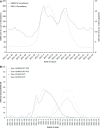Hospital-based influenza morbidity and mortality surveillance system for influenza-like illnesses: a comparison with national influenza surveillance systems
- PMID: 24020512
- PMCID: PMC4177793
- DOI: 10.1111/irv.12175
Hospital-based influenza morbidity and mortality surveillance system for influenza-like illnesses: a comparison with national influenza surveillance systems
Abstract
The Hospital-based Influenza Morbidity and Mortality (HIMM) surveillance system is an emergency room (ER)-based influenza surveillance system in Korea that was established in 2011. The system was established under the assumption that integrated clinical and virologic surveillance could be performed rapidly and easily at seven tertiary hospitals' ER. Here, we assessed the correlation between data generated from the HIMM surveillance system and the Korean national influenza surveillance systems during the 2011-2012 influenza season using cross-correlation analysis and found strong correlations. Rapid antigen-test-based HIMM surveillance would predict the start of influenza epidemic earlier than pre-existing influenza-like-illness-based surveillance.
Keywords: Influenza; Korea; influenza-like illness; surveillance.
© 2013 The Authors. Influenza and Other Respiratory Viruses Published by John Wiley & Sons Ltd.
Figures
Similar articles
-
Disease burden of 2013-2014 seasonal influenza in adults in Korea.PLoS One. 2017 Mar 9;12(3):e0172012. doi: 10.1371/journal.pone.0172012. eCollection 2017. PLoS One. 2017. PMID: 28278158 Free PMC article.
-
Hospital-based influenza surveillance in Korea: hospital-based influenza morbidity and mortality study group.J Med Virol. 2013 May;85(5):910-7. doi: 10.1002/jmv.23548. J Med Virol. 2013. PMID: 23508916
-
Hospital-based Influenza Morbidity and Mortality (HIMM) Surveillance for A/H7N9 Influenza Virus Infection in Returning Travelers.J Korean Med Sci. 2018 Feb 12;33(7):e49. doi: 10.3346/jkms.2018.33.e49. J Korean Med Sci. 2018. PMID: 29359537 Free PMC article.
-
Influenza surveillance within hospitals: what is the world doing?Commun Dis Intell Q Rep. 2007 Dec;31(4):413-8. doi: 10.33321/cdi.2007.31.47. Commun Dis Intell Q Rep. 2007. PMID: 18268885 Review.
-
Update on influenza diagnostics: lessons from the novel H1N1 influenza A pandemic.Clin Microbiol Rev. 2012 Apr;25(2):344-61. doi: 10.1128/CMR.05016-11. Clin Microbiol Rev. 2012. PMID: 22491775 Free PMC article. Review.
Cited by
-
Concordance between the Clinical Diagnosis of Influenza in Primary Care and Epidemiological Surveillance Systems (PREVIGrip Study).Int J Environ Res Public Health. 2022 Jan 23;19(3):1263. doi: 10.3390/ijerph19031263. Int J Environ Res Public Health. 2022. PMID: 35162284 Free PMC article.
-
Hospital surveillance of influenza strains: a concordant image of viruses identified by the Swiss Sentinel system?Influenza Other Respir Viruses. 2017 Jan;11(1):41-47. doi: 10.1111/irv.12417. Epub 2016 Aug 31. Influenza Other Respir Viruses. 2017. PMID: 27441401 Free PMC article.
-
The National Influenza Surveillance System of Korea.Infect Chemother. 2019 Jun;51(2):98-106. doi: 10.3947/ic.2019.51.2.98. Infect Chemother. 2019. PMID: 31270989 Free PMC article. Review.
-
Early Detection of the Start of the Influenza Epidemic Using Surveillance Systems in Catalonia (PREVIGrip Study).Int J Environ Res Public Health. 2022 Dec 19;19(24):17048. doi: 10.3390/ijerph192417048. Int J Environ Res Public Health. 2022. PMID: 36554929 Free PMC article.
-
Early detection of influenza outbreak using time derivative of incidence.EPJ Data Sci. 2020;9(1):28. doi: 10.1140/epjds/s13688-020-00246-7. Epub 2020 Sep 11. EPJ Data Sci. 2020. PMID: 32934899 Free PMC article.
References
-
- Baker AW, Enfield K, Mehring B, Turner JC, Sifri CD. Local influenza-like illness surveillance at a university health system during the 2009 H1N1 influenza pandemic. Am J Infect Control. 2012;40:606–610. - PubMed
-
- Wunderli W, Thomas Y, Muller DA, Dick M, Kaiser L. Rapid antigen testing for the surveillance of influenza epidemics. Clin Microbiol Infect. 2003;9:295–300. - PubMed
-
- Iha Y, Higa F, Sunagawa S, et al. Effect of climatic conditions on epidemic patterns of influenza in Okinawa, Japan, during the pandemic of 2009: surveillance of rapid antigen test results. Jpn J Infect Dis. 2012;65:295–300. - PubMed
Publication types
MeSH terms
Substances
LinkOut - more resources
Full Text Sources
Other Literature Sources
Medical


